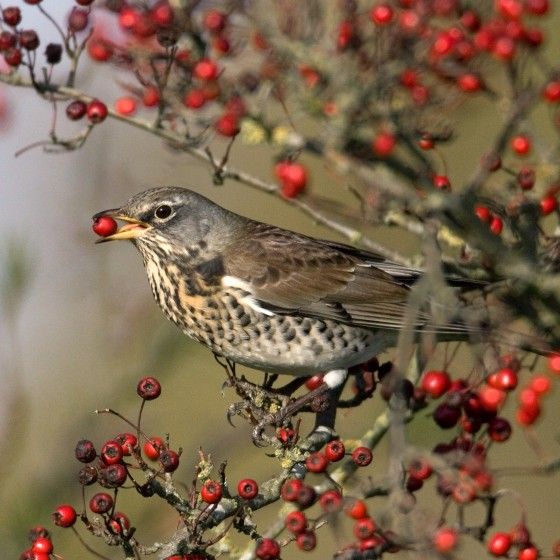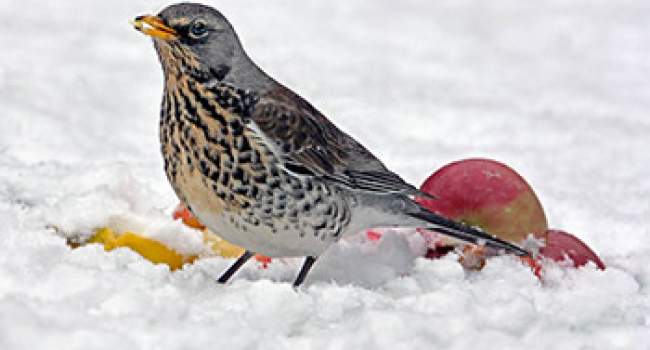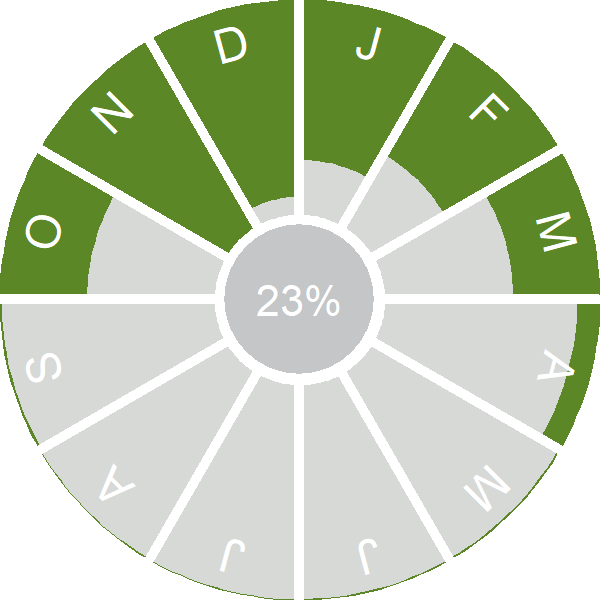Fieldfare
Turdus pilaris (Linnaeus, 1758)
FF
 FIELD
FIELD  11980
11980

Family: Passeriformes > Turdidae

The grey-headed, chestnut-backed Fieldfare is the largest of the thrushes, and visits Britain & Ireland during the winter months.
Fieldfares begin arriving on the UK's eastern coasts from Fennoscandia, western Russia and eastern Europe during early October. Numbers vary each year and are dependent on berry crops closer to their breeding grounds. In years when crops are poor, Fieldfares move in large numbers in search of berries elsewhere and it is under these conditions that the largest numbers occur in Britain & Ireland.
Ringing data demonstrate that Fieldfares visiting the UK have been found in 18 different countries. In some years one or two pairs breed in upland parts of the UK. Fieldfare has been on the UK Red List since 2009.
Identification
Fieldfare identification is often straightforward. The following article may help when identifying Fieldfare.
Identifying Redwing and Fieldfare

These two winter thrushes are easily told from each other. However, Redwing can be confused with Song Thrush, whilst Fieldfare is similar in size and appearance to Mistle Thrush. In this, the latest identification video from the BTO, we offer tips on how to confidently separate these engaging thrushes.
SONGS AND CALLS
Listen to example recordings of the main vocalisations of Fieldfare, provided by xeno-canto contributors.
Flight call
Call
Develop your bird ID skills with our training courses
Our interactive online courses are a great way to develop your bird identification skills, whether you're new to the hobby or a competent birder looking to hone your abilities.
Browse training coursesStatus and Trends
Population size and trends and patterns of distribution based on BTO surveys and atlases with data collected by BTO volunteers.
CONSERVATION STATUS
This species can be found on the following statutory and conservation listings and schedules.
POPULATION CHANGE
The Fieldfare is predominantly a winter visitor to the UK from Fennoscandia and the numbers breeding in the UK are tiny in comparison. There has been a strong decrease in breeding numbers over the 25 years to 2019 and just a handful of breeding records have been reported to the RBBP in recent years,with a mean of just one breeding pair over the five-year period 2015–2019 (Eaton et al. 2021).
| UK breeding population |
No population change in UK (1995–2022) 
|
DISTRIBUTION
Fieldfares are widely distributed in winter, with the exception of major urban areas and the highest ground in northern Scotland and in northwest Ireland. They shows a preference for low-lying land, where they feed in open farmland, hedgerows and woodland, only moving into gardens during harsh winter weather. The highest concentrations are found in southeast and central England. Outside winter, Fieldfares are a very rare breeder, with confirmed breeding during 2008–11 recorded in just four locations, three in Scotland and one in northern England.
Occupied 10-km squares in UK
| No. occupied in breeding season | 23 |
| % occupied in breeding season | 0.8 |
| No. occupied in winter | 2791 |
| % occupied in winter | 92 |
European Distribution Map
DISTRIBUTION CHANGE
Winter range has changed little. The breeding range appears to have shrunk but this may be an artefact of many previous Fieldfare records being assigned breeding evidence when in fact they were late-departing winter migrants.
Change in occupied 10-km squares in the UK
| % change in range in breeding season (1968–72 to 2008–11) | -32.4% |
| % change in range in winter (1981–84 to 2007–11) | +3.7% |
SEASONALITY
Fieldfare is largely a winter visitor, arriving from continental breeding grounds in October and remaining into late winter and early spring. The tiny breeding population is rarely encountered on complete lists and does not appear here.

Movement
Information about movement and migration based on online bird portals (e.g. BirdTrack), Ringing schemes and tracking studies.
An overview of year-round movements for the whole of Europe can be seen on the EuroBirdPortal viewer.
RINGING RECOVERIES
View a summary of recoveries in the Online Ringing Report.
Foreign locations of birds ringed or recovered in Britain & Ireland

Biology
Lifecycle and body size information about Fieldfare, including statistics on nesting, eggs and lifespan based on BTO ringing and nest recording data.
SURVIVAL & LONGEVITY
View number ringed each year in the Online Ringing Report
Maximum Age from Ringing 
|
14 years 8 months 24 days (set in 2010) 
|
Typical Lifespan 
|
2 years with breeding typically at 1 year |
Adult Survival 
|
0.41  
|
Juvenile Survival 
|
0.31 (in first year) 
|
BIOMETRICS
Wing Length 
|
Adults | 148.2±4.2 | Range 142–155mm, N=5122 |
| Juveniles | 147.1±4.1 | Range 141-153mm, N=2216 | |
| Males | 150.2±3.7 | Range 144–156mm, N=2259 | |
| Females | 146.6±3.9 | Range 140–153mm, N=2696 |
Body Weight 
|
Adults | 109±10.7 | Range 92.0–127g, N=4394 |
| Juveniles | 108±10.5 | Range 89.6–124g, N=1830 | |
| Males | 111±10.4 | Range 94.0–127g, N=1920 | |
| Females | 108±10.6 | Range 91.0–125g, N=2343 |
Feather measurements and photos on featherbase 
CODES & CLASSIFICATION
Ring size 
|
C |
Field Codes 
|
2-letter: FF | 5-letter code: FIELD | Euring: 11980 |
For information in another language (where available) click on a linked name
Research
Interpretation and scientific publications about Fieldfare from BTO scientists.
CAUSES AND SOLUTIONS
Causes of change
Reasons for the decline in numbers of breeding Fieldfare in the UK are not known.
Links to more studies from ConservationEvidence.com
- Avian response to nest box addition in two forests of the Colorado Front Range
- Nest-site fidelity in eastern bluebirds (Sialia sialis) depends on the quality of alternate cavities
- Could game management have a role in the conservation of farmland passerines? A case study from a Leicestershire farm
Read more studies about Fieldfare on Conservation Evidence >
Would you like to search for another species?












Share this page